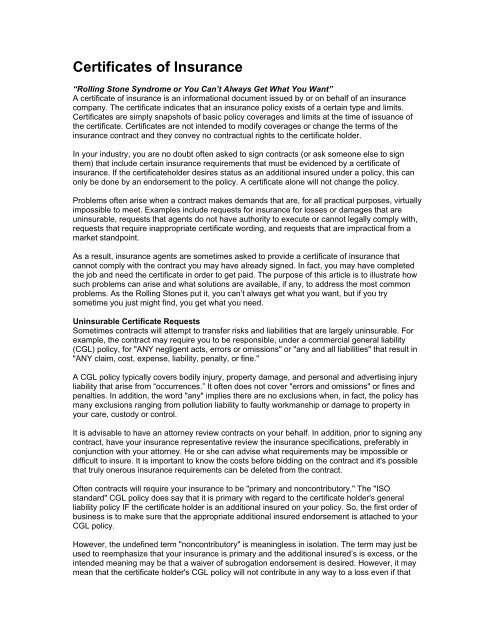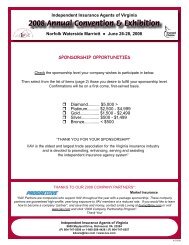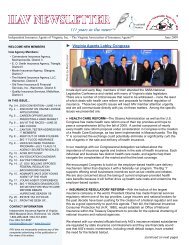to all member individuals - Independent Insurance Agent
to all member individuals - Independent Insurance Agent
to all member individuals - Independent Insurance Agent
You also want an ePaper? Increase the reach of your titles
YUMPU automatically turns print PDFs into web optimized ePapers that Google loves.
Certificates of <strong>Insurance</strong><br />
“Rolling S<strong>to</strong>ne Syndrome or You Can’t Always Get What You Want”<br />
A certificate of insurance is an informational document issued by or on behalf of an insurance<br />
company. The certificate indicates that an insurance policy exists of a certain type and limits.<br />
Certificates are simply snapshots of basic policy coverages and limits at the time of issuance of<br />
the certificate. Certificates are not intended <strong>to</strong> modify coverages or change the terms of the<br />
insurance contract and they convey no contractual rights <strong>to</strong> the certificate holder.<br />
In your industry, you are no doubt often asked <strong>to</strong> sign contracts (or ask someone else <strong>to</strong> sign<br />
them) that include certain insurance requirements that must be evidenced by a certificate of<br />
insurance. If the certificateholder desires status as an additional insured under a policy, this can<br />
only be done by an endorsement <strong>to</strong> the policy. A certificate alone will not change the policy.<br />
Problems often arise when a contract makes demands that are, for <strong>all</strong> practical purposes, virtu<strong>all</strong>y<br />
impossible <strong>to</strong> meet. Examples include requests for insurance for losses or damages that are<br />
uninsurable, requests that agents do not have authority <strong>to</strong> execute or cannot leg<strong>all</strong>y comply with,<br />
requests that require inappropriate certificate wording, and requests that are impractical from a<br />
market standpoint.<br />
As a result, insurance agents are sometimes asked <strong>to</strong> provide a certificate of insurance that<br />
cannot comply with the contract you may have already signed. In fact, you may have completed<br />
the job and need the certificate in order <strong>to</strong> get paid. The purpose of this article is <strong>to</strong> illustrate how<br />
such problems can arise and what solutions are available, if any, <strong>to</strong> address the most common<br />
problems. As the Rolling S<strong>to</strong>nes put it, you can’t always get what you want, but if you try<br />
sometime you just might find, you get what you need.<br />
Uninsurable Certificate Requests<br />
Sometimes contracts will attempt <strong>to</strong> transfer risks and liabilities that are largely uninsurable. For<br />
example, the contract may require you <strong>to</strong> be responsible, under a commercial general liability<br />
(CGL) policy, for "ANY negligent acts, errors or omissions" or "any and <strong>all</strong> liabilities" that result in<br />
"ANY claim, cost, expense, liability, penalty, or fine."<br />
A CGL policy typic<strong>all</strong>y covers bodily injury, property damage, and personal and advertising injury<br />
liability that arise from “occurrences.” It often does not cover "errors and omissions" or fines and<br />
penalties. In addition, the word "any" implies there are no exclusions when, in fact, the policy has<br />
many exclusions ranging from pollution liability <strong>to</strong> faulty workmanship or damage <strong>to</strong> property in<br />
your care, cus<strong>to</strong>dy or control.<br />
It is advisable <strong>to</strong> have an at<strong>to</strong>rney review contracts on your behalf. In addition, prior <strong>to</strong> signing any<br />
contract, have your insurance representative review the insurance specifications, preferably in<br />
conjunction with your at<strong>to</strong>rney. He or she can advise what requirements may be impossible or<br />
difficult <strong>to</strong> insure. It is important <strong>to</strong> know the costs before bidding on the contract and it's possible<br />
that truly onerous insurance requirements can be deleted from the contract.<br />
Often contracts will require your insurance <strong>to</strong> be "primary and noncontribu<strong>to</strong>ry." The "ISO<br />
standard" CGL policy does say that it is primary with regard <strong>to</strong> the certificate holder's general<br />
liability policy IF the certificate holder is an additional insured on your policy. So, the first order of<br />
business is <strong>to</strong> make sure that the appropriate additional insured endorsement is attached <strong>to</strong> your<br />
CGL policy.<br />
However, the undefined term "noncontribu<strong>to</strong>ry" is meaningless in isolation. The term may just be<br />
used <strong>to</strong> reemphasize that your insurance is primary and the additional insured’s is excess, or the<br />
intended meaning may be that a waiver of subrogation endorsement is desired. However, it may<br />
mean that the certificate holder's CGL policy will not contribute in any way <strong>to</strong> a loss even if that
policy otherwise covers it. This could mean that you will have <strong>to</strong> pay out of your own pocket any<br />
claim that exceeds the limit of your CGL policy without contribution from the certificate holder's<br />
CGL policy.<br />
It is in your best interest <strong>to</strong> attempt <strong>to</strong> clarify and, if necessary, strike the "noncontribu<strong>to</strong>ry"<br />
wording from the contract. If that's impossible, consider increasing your own policy limits or be<br />
prepared <strong>to</strong> assume a potenti<strong>all</strong>y large uninsured loss.<br />
“Illegal” Certificate Requests<br />
Certain contracts require that the certificate holder be given additional insured status under a<br />
specific endorsement number and edition date. It is not uncommon for a contract <strong>to</strong> request an<br />
"ISO standard" policy form such as the CG 20 10 11 85 additional insured endorsement. Note<br />
that "11 85" refers <strong>to</strong> the November 1985 edition of this form. These forms typic<strong>all</strong>y must be filed<br />
with state insurance departments before they can be used. Since later editions may have<br />
superseded earlier editions, it could be impossible <strong>to</strong> provide a form that is 20+ years old and has<br />
been withdrawn by insurance department filing.<br />
Your insurance agent can often provide a later edition form with comparable coverage. In some<br />
cases, two endorsements might be necessary <strong>to</strong> replace a single older form, one providing<br />
ongoing operations coverage and the other completed operations coverage.<br />
The latter form, however, might not be available or only available at significant cost. If your<br />
insurance representative is an independent agent, he or she will represent more than one<br />
insurance company, making it more likely that your insurance can be offered <strong>to</strong> another insurer<br />
who is better able <strong>to</strong> meet your needs. In any event, you will want <strong>to</strong> price this coverage before<br />
submitting your bid since completed operations insurance, if available, can be substantial in price.<br />
Also, contracts frequently mandate that coverage be extended <strong>to</strong> the additional insured's sole<br />
negligence. In most states, sole negligence cannot leg<strong>all</strong>y be transferred <strong>to</strong> another party.<br />
Increasingly, even where insurance transfer is permitted, insurers are using additional insured<br />
endorsements that prohibit assuming the additional insured's sole negligence. The current “ISO<br />
standard” endorsements do just that.<br />
If you are in a state that has anti-indemnity statutes or case law, then this should not be an issue.<br />
Otherwise, you will want your insurance agent <strong>to</strong> determine if the insurer is still willing <strong>to</strong> assume<br />
sole negligence under an additional insured endorsement. If not, the contract will need <strong>to</strong> be<br />
modified or compliance will be impossible.<br />
Inappropriate Certificate Requests<br />
Contracts often specify that the certificate of insurance provide for a notice of cancellation <strong>to</strong> the<br />
certificate holder. The problem is that <strong>all</strong> "ISO standard" additional insured endorsements make<br />
no provision for cancellation notice <strong>to</strong> an additional insured. Perhaps acknowledging this, some<br />
contracts settle for the more hopeful "endeavor <strong>to</strong>" provide notice of cancellation provision.<br />
Keep in mind that, unless the additional insured endorsement provides for cancellation notice, the<br />
insurer is usu<strong>all</strong>y under no contractual obligation <strong>to</strong> provide such notice. Even if an attempt is<br />
voluntarily made, mistakes happen. In some cases, due <strong>to</strong> regula<strong>to</strong>ry decree by the state<br />
department of insurance (New York is an example), a certificate of insurance cannot make a<br />
promise of notification unless notice of cancellation is provided for in the policy or endorsement.<br />
Some organizations and government entities use their own certificates of insurance in lieu of the<br />
more standardized ACORD 25 - Certificate of Liability <strong>Insurance</strong> form. These may create<br />
problems for insurance agents because some states have laws or regulations prohibiting the use<br />
of such forms unless approved by the state department of insurance.
These forms may include wording implying coverages or rights that don't actu<strong>all</strong>y exist under the<br />
policy, again violating the law in many states, and may lack disclaimers designed <strong>to</strong> protect you<br />
and the issuer. These certificates may sometimes be almost exact duplicates of the "ACORD<br />
standard" form(s), creating copyright violation possibilities.<br />
Be very wary of these non-ACORD certificates of insurance. Rely on your independent insurance<br />
agent for guidance on how <strong>to</strong> handle these forms. In many cases, they can be issued, but require<br />
referral <strong>to</strong> the insurance company which can cause delays. Again, it is important <strong>to</strong> involve your<br />
insurance representative in the process as soon as possible.<br />
Impractical Certificate Requests<br />
The contract may specify that certain coverages (e.g., completed operations) be provided or that<br />
certain exclusions (e.g., pollution liability) be removed. Because of the proliferation of defective<br />
workmanship claims in the construction industry, completed operations coverage may be difficult<br />
<strong>to</strong> procure at a reasonable cost. Most insurers are unwilling <strong>to</strong> remove certain exclusions such as<br />
pollution liability and the cost <strong>to</strong> purchase the coverage separately may be prohibitive.<br />
Be sure <strong>to</strong> give your insurance representative ample time <strong>to</strong> search for insurers willing and able <strong>to</strong><br />
provide the coverages required by your contracts. If coverages are available, the premium costs<br />
need <strong>to</strong> be included in your contract bid. If coverages are not available, you may be able <strong>to</strong><br />
negotiate such requirements from the contract or pursue another source of coverage.<br />
It is not uncommon for your insurance representative <strong>to</strong> be unable <strong>to</strong> meet every requirement of<br />
the contract you're being asked <strong>to</strong> sign, from the standpoint of coverages, policy rights, or<br />
completion of a certificate of insurance. The other party <strong>to</strong> the contract may then inform you that<br />
they can provide a list of agents who claim they can comply with the contractual requirements in<br />
full.<br />
While it's possible that the person requesting the certificate is aware of agents who are better<br />
able <strong>to</strong> comply with their requests, be cognizant that fraud and misrepresentation with regard <strong>to</strong><br />
certificates is not unheard of. If you are requiring certificates from subcontrac<strong>to</strong>rs, be aware that<br />
bogus certificates do exist.<br />
While it is rare, there are unfortunately some insurance agents who will issue certificates that do<br />
not accurately reflect coverages and policy terms just <strong>to</strong> <strong>all</strong>ow a contrac<strong>to</strong>r <strong>to</strong> get a job or a loan<br />
<strong>to</strong> close and for the agent <strong>to</strong> retain the account. Since certificates are rarely leg<strong>all</strong>y enforceable<br />
against insurers or agents, you may be incurring significant liability if a certificate is issued that<br />
does not accurately reflect contract terms. It is important <strong>to</strong> do business with insurance<br />
professionals you trust implicitly and that you verify the accuracy of the certificate.<br />
As outlined in this discussion, the single best thing you can do in dealing with certificate of<br />
insurance requirements is <strong>to</strong> involve your independent insurance agent before committing<br />
yourself <strong>to</strong> something that cannot be accomplished. He or she can counsel you on how <strong>to</strong> best<br />
meet your insurance requirements and, if not possible in some instances, provide an explanation<br />
as <strong>to</strong> why something is difficult or impossible, often <strong>to</strong> the satisfaction of the reques<strong>to</strong>r.<br />
Copyright © 2007-2008 by the <strong>Independent</strong> <strong>Insurance</strong> <strong>Agent</strong>s and Brokers of America, Inc. All<br />
rights reserved.








